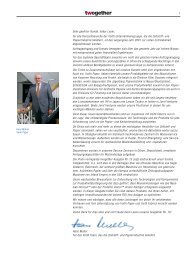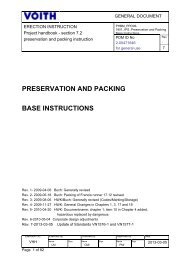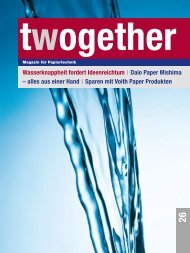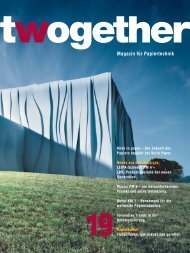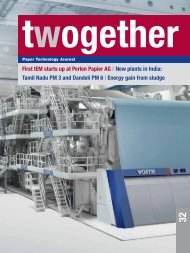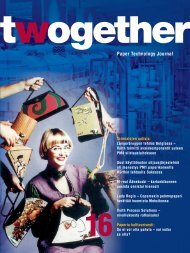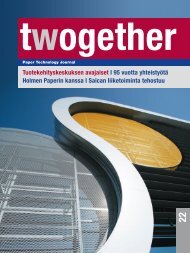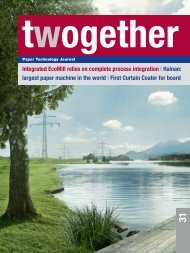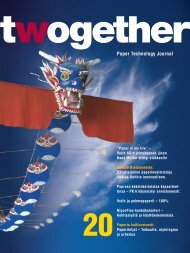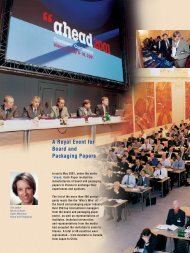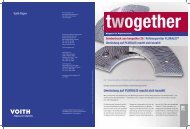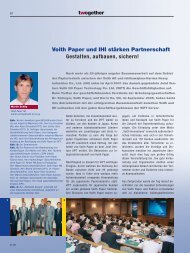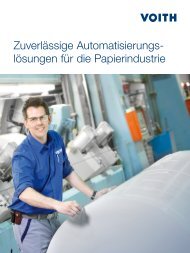Create successful ePaper yourself
Turn your PDF publications into a flip-book with our unique Google optimized e-Paper software.
28<br />
Dr. Jens Müller<br />
<strong>Paper</strong> Machines Graphic<br />
jens.mueller@voith.com<br />
<strong>17</strong>/04<br />
NipcoFlex and TissueFlex –<br />
Shoe press technology for the dewatering<br />
of all paper grades<br />
The important technological and economic advantages have<br />
expanded the use of shoe press technology to the dewatering of all paper<br />
products from pulp to tissue. Whereas the development of NipcoFlex technology<br />
began in packaging paper machines 20 years ago, this technology<br />
can today be found in virtually all applications for the mechanical dewatering<br />
of the paper web in new and modernized production systems. The portfolio<br />
offers an economic solution for increasing productivity and efficiency<br />
for any requirement, whether a rebuild or a new machine. The advantages<br />
of shoe press technology are now also utilized in calendering in the paper<br />
industry.<br />
Application range<br />
Since the introduction of closed shoe<br />
presses in the paper industry in 1984,<br />
over 400 shoe presses have been put into<br />
operation. Of these, <strong>Voith</strong> has received<br />
orders for 280 systems (Fig. 1). The size<br />
of these systems is between 2 m to almost<br />
11 m paper width in the press nip.<br />
Equally large is the range of the speeds<br />
that have been implemented. These extend<br />
from 50 m/min in pulp dewatering<br />
up to 2,000 m/min on tissue machines.<br />
Graphic paper<br />
The first shoe press for graphic papers<br />
was put into operation in 1995. The benefits<br />
of shoe press technology have led to<br />
the fact that today more than 100 Nipco-<br />
Flex Presses are used for the production<br />
of these grades. In contrast to a conventional<br />
press nip, the shoe press offers the<br />
possibility of varying the pressure in the<br />
press nip. The pressure profiles are indi-<br />
vidually adapted to the technological requirements<br />
of the production process<br />
concerned and the pressure shoes are<br />
manufactured accordingly. The pressure<br />
profile is designed for gentle dewatering<br />
for a uniform sheet structure with as high<br />
a bulk and dryness as possible. In the<br />
NipcoFlex Roll (Fig. 2) the pressure shoe<br />
is pressed-on by individual loading elements.<br />
The pressure shoe is generally<br />
made in two parts. The top and bottom<br />
are thermally isolated from each other in<br />
order to extensively avoid deformations<br />
due to temperature. To achieve the most<br />
favorable inlet geometry for the press<br />
sleeve, the pressure shoe is shifted towards<br />
the ingoing nip. Shortly after the<br />
outgoing nip, cool lubricating oil is applied<br />
to the inside of the sleeve. A large<br />
part of this lubricating oil is removed out<br />
of the oil sump that forms ahead of the<br />
ingoing nip. The other part of the lubricating<br />
oil serves for hydrodynamic lubrication<br />
between pressure shoe and press<br />
sleeve. If the production speed, linear



